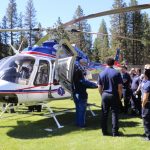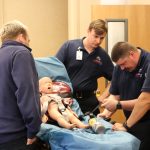 College of the Siskiyous Preps California Paramedics for Action
College of the Siskiyous Preps California Paramedics for Action
In a career where every second counts, paramedics need to be ready for anything.
That preparation has to start somewhere, and when it comes to setting a foundation for future first responders in the Far North, the College of the Siskiyous Emergency Medical Services program is providing the spark.
“We’re confident in our ability to take students from zero to hero and do a really good job of it,” says Kirk Thomsen, EMS Program Coordinator and Paramedic Program Director at College of the Siskiyous.
The proven program not only equips grads with essential emergency medical service skills, it helps emergent EMTs land jobs with employers throughout the Far North region and beyond. Grads have scored positions all the way from Mendocino County, to Novato and Marin County in the North Bay, to almost 500 miles south working for CAL Fire in Riverside.
“We have former students embedded everywhere throughout the state,” says Thomsen. “Word of mouth gets around. The employers are like, ‘We like the caliber of paramedic student that you’re putting out. We want more of that.’”
Thanks to the high-impact, hands-on program, COS grads are clocking near perfect success rates on the National Certification test. Through enlightening lectures and engaging, four-hour lab periods, students are getting a sense of the grit it takes to get to the next level in the EMS field.
“I would say that ‘accomplished’ would be a good way to describe them,” lead Paramedic Instructor Connie Duffle says about her most recent cohort of students. “They accomplished a lot. They were able to learn a lot and apply it reasonably well.”
From learning the interfaces of various cardiac monitors to understanding the team dynamic in the back of an ambulance, the rigorous curriculum is designed to prepare students for the fast-paced reality of the field.
“We really try to reinforce everything that they learned that day and up to that point in the program during lab time,” continues Duffle. “We’re practicing intubations, needle decompressions, and cricothyrotomies, and we’re doing scenarios that incorporate all of those skills as well.”
Hands-on training like this is paramount to success in the evolving emergency services industry. The essential COS experience includes training on the same, industry-grade equipment that paramedics would regularly encounter on the job. In order to upgrade the program’s older, donated equipment, Thomsen connected to Strong Workforce Program funding and purchased an array of new resources for both the college’s Emergency Medical Technician (EMT) and Paramedic programs.
“The Paramedic [program] definitely has more expensive equipment,” notes Thomsen. “When I got here, we had older equipment, and it just wasn’t what … we’re using in the field.”
After serving 30 years in the fire service, and nearly 20 years as a paramedic, Thomsen knows the specific skills students need to thrive in the EMS field. When the director came to the EMS program after “failing retirement” in 2020, Thomsen committed to ensuring his students had access to the best possible launch pad.
“You could come into our program fresh out of EMT school,” says Thomsen. “You’re going to struggle, you’re going to have to work harder, but we give you all the tools you need to succeed.”
The college is getting its money’s worth with the SWP funding, as the EMT and Paramedic programs share much of the same equipment. High-tech training toys include Zoll and Stryker cardiac monitors, covering an array of brands students will be using out in the field, and even a brand-new ambulance to practice treating patients.
“It’s better than any simulation,” says the Paramedic program director. “We’ve gotten donated [ambulances], and sometimes the donated ones are marginal mechanically at best … and so, this last Fall … we purchased a brand-new ambulance, and we always joke that nobody’s ever puked, bled, or died in it.
“The better educational [equipment] you can get, the more realistic it seems for a student.”
The Strong Workforce dollars are also being used to spread the word, as in the case of a new wrap on the recently purchased ambulance advertising the College’s EMS program. The idea is to take the vehicle to high schools, community events and other visible locations to help showcase the top-quality EMS and Paramedic programs.
“It’s a giant driving billboard,” explains Thomsen. “It’s a beautiful showpiece that we can take around and try to recruit people to our program.”
Once students complete the Paramedic program didactic, they’re required to participate in an internship, gaining practical skills such as starting IVs, administering drugs, and performing intubations. These future EMS professionals will spend a minimum of 480 hours in an ambulance, working directly with experienced paramedics in the field.
“Eventually, they’re running the calls,” says Thomsen. “Those internships prepare them to be successful.”
Whether students choose to move forward as ambulance paramedics, firefighter paramedics, hospital technicians, emergency room technicians, or members of disaster management teams, they’ll be fully equipped to encounter the often-chaotic world of emergency services.
“Our business can have challenges,” explains Thomsen. “The first time you see something horrible happening to somebody else, you’re either prepared or you’re like, ‘I wish I would’ve known this was going to happen.
“That’s why we use realistic equipment [and] simulations.”
Duffle agrees that adaptation and improvisation are key facets of a first responder’s skillset.
“This is one of those things where you walk in, and it could be anything,” adds Duffle. “[Successful students exhibit] the ability to learn by watching and by doing, and also the ability to physically assess what is wrong and change their treatment plans based on how their patient is presenting.”
Momentum continues to build at COS, with a bachelor’s degree program in paramedicine debuting Fall 2025. The degree pathway will be the first of its kind in California, harnessing Strong Workforce funding to provide faculty and equipment support. Meanwhile, the EMS and Paramedic satellite program is celebrating its third year at the Mendocino College campus, connecting even more students to game-changing EMS training.
“They … provide a space,” says Thomsen about the satellite program. “It’s our instructor, our equipment, [and] our students.”
The program’s expansion comes at an opportune time, with statewide agencies on high alert for talent in the EMS and paramedic field. Last year, CAL Fire Riverside in Southern California had 116 firefighter paramedic positions they couldn’t fill. Thomsen says a CAL Fire Riverside representative makes a visit to their program every year to recruit for these in-demand positions.
Meanwhile, the Occupational Information Network (ONET) projects about 2,000 annual job openings throughout California for paramedics until 2030, marking a 15 percent boost that amounts to nearly three times the average growth rate for all careers.
“Pretty much one hundred percent of our students are employed after their time in the program,” says Thomsen. “Some of them are even recruited before the end of the program.”
Sources:
https://www.onetonline.org/link/localtrends/29-2043.00?st=CA
June 2024